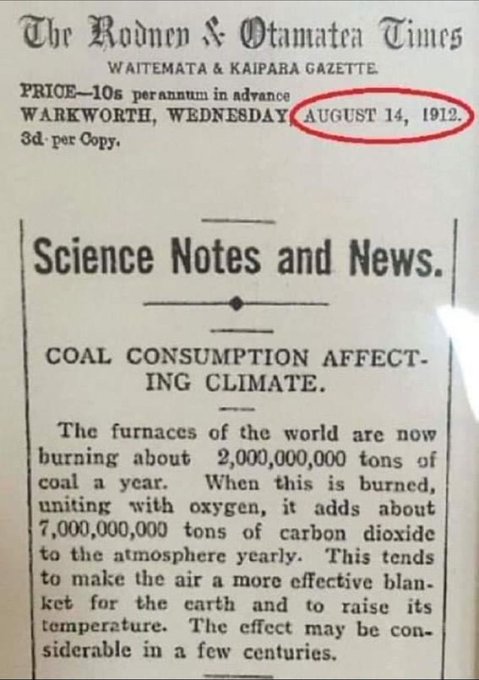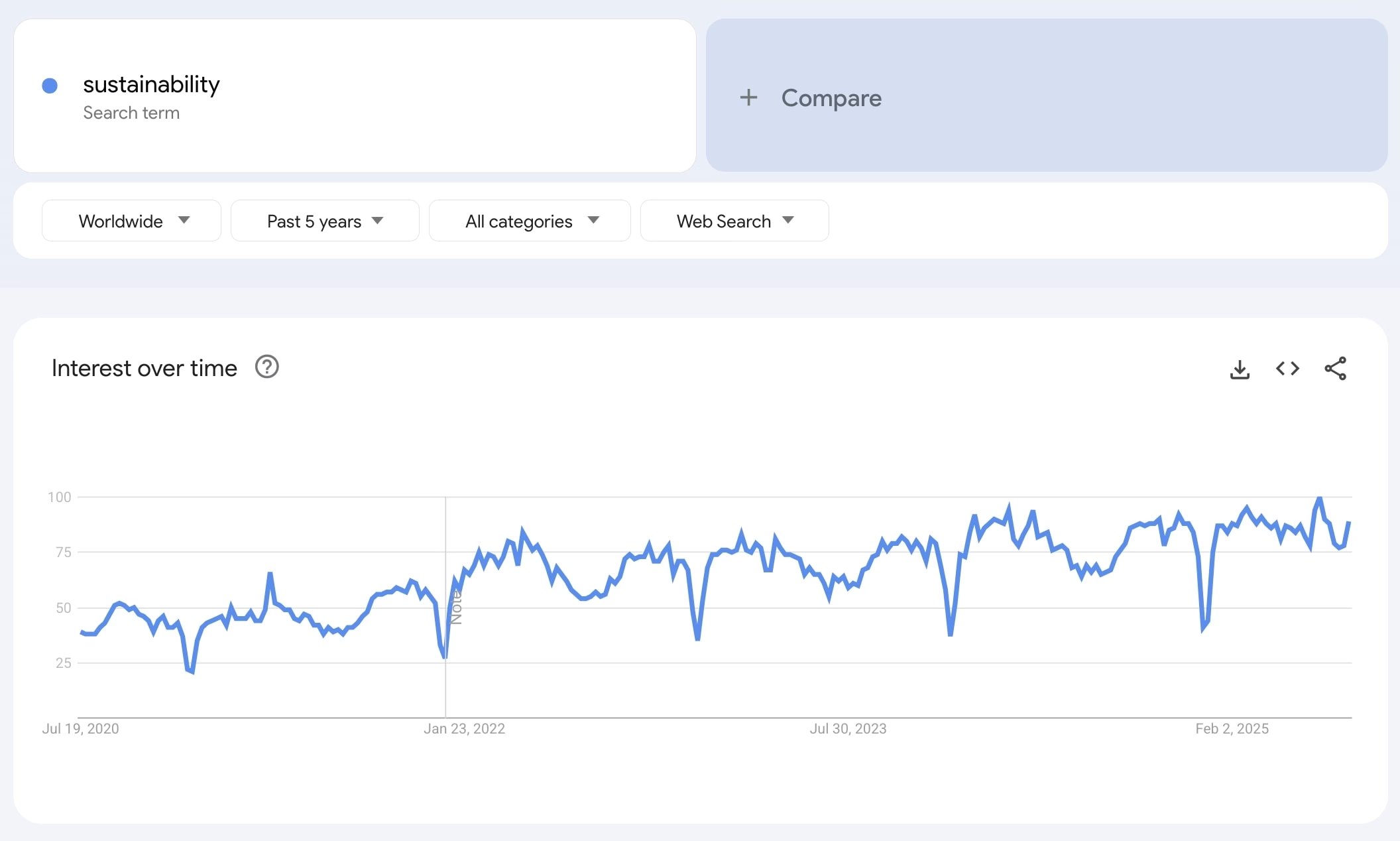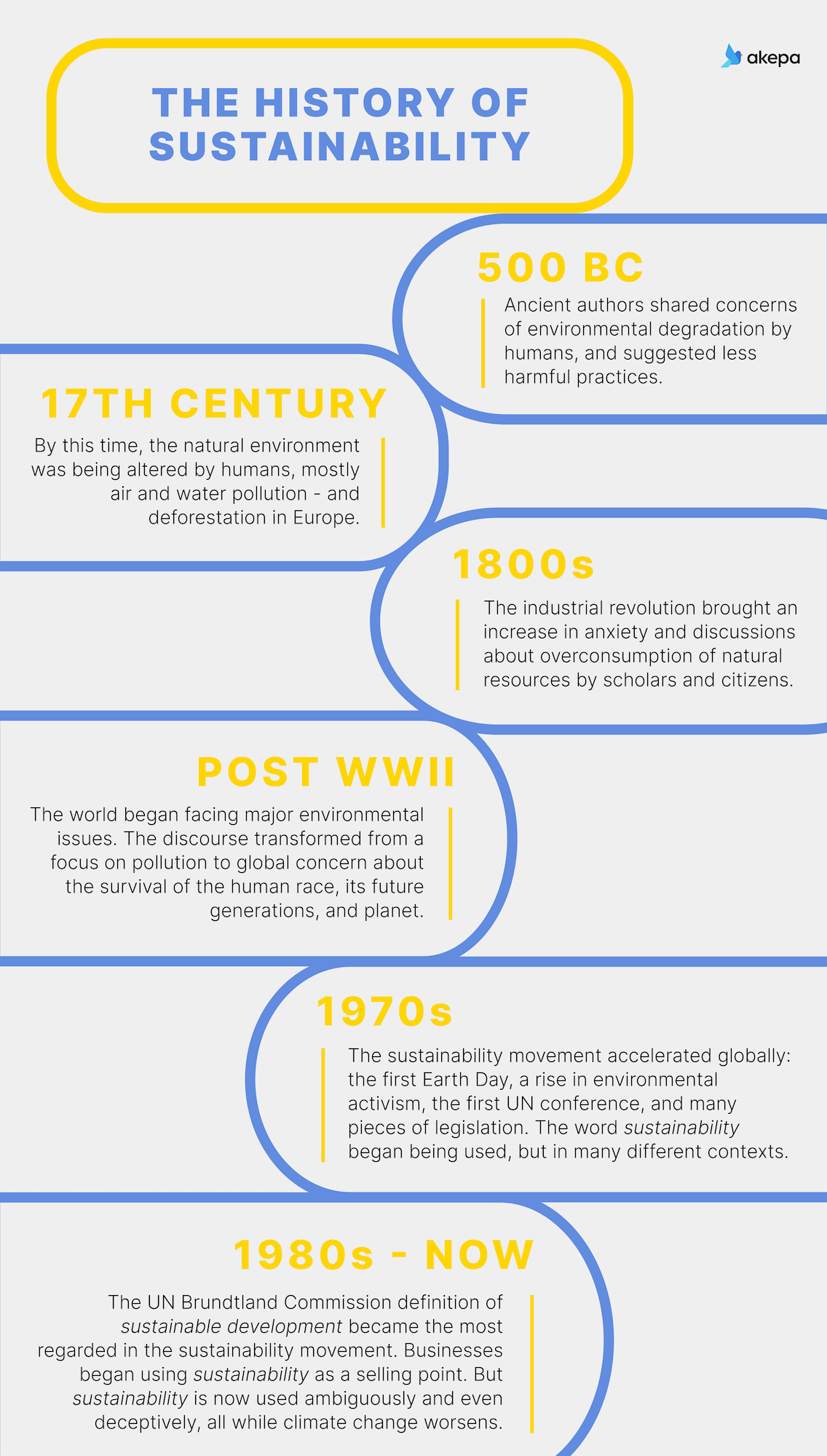Sustainability. Where do we even start with this word? It must be one of the most popular enigmas out there. So we dove into the history of the concept and how the word evolved to be used in its present context.
When did this imbalance begin? When did we arrive at the point where human activity became the top driver of the destruction of our planet? How did ‘sustainable’ become a word so easily thrown around to make something sound more appealing?
Before we get into a rant (if you’re passionate about sustainability too, we’re sure you’ll understand), let’s dive in! But use these links if you want to travel to an era of your choice:
- Pre-Industrial Days: there were warnings
- Industrial Revolution: concerns for the environment grew
- The lead up to the sustainability explosion in the 1970s
- The past 50 years: sustainability became a global concern
- Now: sustainability is urgent
- Overview: timeline
Pre-Industrial Days: there were warnings
It’s said that the concept of sustainability began during the industrial revolution. And it’s true that CO2 and greenhouse gas emissions were far lower before that era.

But records reveal that the environment showed signs of degradation even earlier. Yes, the human-induced effects to the climate were small against today’s. But air and water pollution were common in Europe. Also, deforestation led to environmental disasters. The point here is that we’re not romanticising the idea of pre-industrial life as flawless for the environment.
But were people thinking about sustainability and making sustainable choices? It’s doubtful that environmental impacts and their effect on future generations were being thought about en-masse, like today. Yet, despite a scarcity of records, some ancient yet forward-thinking authors dating from as far back as 500 BC discussed concern for environmental degradation resulting from human activities, and recommended less harmful practices. The word sustainability may not have been used. But it’s clear that discussions were had about what would be considered sustainable choices today.
What’s interesting is that the equivalent words for sustainability in English had already been used similarly for centuries in other languages:
- French: durabilité and durable
- German: Nachhaltigkeit and nachhaltig
- Dutch: duurzaamheid and duurzaam
Industrial Revolution: concerns for the environment grew
As human societies transformed and technology advanced, lives were enhanced. But progress came with unequal distribution of wealth, exploitation of raw materials on a global scale, and the creeping greenhouse gas emissions shown earlier.

By 1804, the world had around 1 billion people. Just before that, in 1798, Thomas Malthus famously predicted that population growth would always surpass food supply. That added to less famous concerns about sustainability from earlier on in history.
The 19th century saw more discussions on the environmental and social impacts of industrialisation. Concerned citizens formed environmentalist groups – mainly for wildlife conservation – such as the Sierra Club in 1892. Publications were released discussing what we’d refer to as sustainable development today, such as George Perkins Marsh’s in 1864. He predicted potential human extinction on Earth due to our interventions on the natural environment.

Above is another mention of our impacts on future generations – from the late industrial era, in a 1912 newspaper. It’s a snapshot in time that shows that concerns about sustainability are not so new.
The lead up to the sustainability explosion in the 1970s
As the 20th century trundled on, so did our impact on the environment and emissions into the atmosphere. Environmental concerns grew too – especially after World War II. In the same way that the Industrial Revolution brought wealth, better living standards, technological/societal advances – and also critical concern regarding sustainability, so did the decades after World War II. Well, it’s no surprise that history repeats itself.
During the 1950s, environmental groups warned about the consequences of plastics, chemicals, synthetics, pesticides, and fossil fuels. At the same time, the world faced significant environmental issues. Namely, the 1952 air pollution incident in London that killed 12,000 people. It wasn’t until then that the issue was taken more seriously.
Time travelling into the future for a moment, in January 2024, new documents revealed that the fossil fuel industry was aware of climate threats during this era, as early 1954! The foundation of this early research on today’s conception of human-induced climate change, conducted by Charles David Keeling, was in fact partially funded by oil and automobile companies.
There was one particular book published in 1962, The Silent Spring, that helped shape the way people see the environmental movement now. Up until then, environmentalism was based on pollution and nature conservation. The movement transformed. Environmental concerns became alarming to the average citizen, stimulating the fear that economic growth at the current rate could endanger the survival of humans and the planet. Perhaps the beginning of the climate anxiety that affects us today.
Through the 1970s, the movement accelerated globally. April 22nd, 1970 brought the first Earth Day. Greenpeace was founded in 1971.


In 1972, sustainability was first used in a similar context as today, regarding the future of humanity. A leading magazine published a series of articles called Blueprint for Survival. It involved more than 30 scientists who recommended that we live in small, de-industrialized communities, among other suggestions.
During the same year, the first UN conference was held on the Human Environment, with victims of environmental disasters telling their stories to raise attention to politicians. Over the next few years, important acts of legislation were enacted. At the same point in the timeline, we also find the ‘hippy’ movement.
The past 50 years: sustainability becomes a global concern
In 1987, the ‘Our Common Future’ report by the UN Brundtland Commission was published. In it is one of the most regarded, simplified definitions in the sustainability movement, which popularized the term sustainable development:
“Sustainable development is development that meets the needs of the present without compromising the ability of future generations to meet their own needs.”
But despite the wide acceptance of this definition, there still are other definitions of sustainable development and sustainability that don’t meet this interpretation of the concept.
On June 23, 1988, global warming became recognized on a wider scale after a NASA scientist testified to the world that the climate was changing. Around this time, though, businesses started to consider environmentalism as a selling point. And coincidentally this is also where the first mention of greenwashing appears. The term was coined by Jay Westerveld in a 1986 essay examining the dubious practices of the hotel industry. To be precise, hotels’ tendencies to implore guests to reuse towels to help the environment, in the absence of any other eco-friendly measures from them. Yep, greenwashing all started with hotel towels and you still get these notices today.

And with the alarming signals of climate change, buyers began to realise their purchasing power and make changes to consumption in the 1990s. This fueled the start of more sustainable products.

By the 1990s, sustainability had also become a familiar term in the world of policy jargon – President Bill Clinton’s Council on Sustainable Development, for example – but not everyone was comfortable. Bill McKibben, one of the most influential environmentalists of the past 30 years, wrote an opinion piece in the New York Times in 1996. In it, he dismissed sustainability as a “buzzless buzzword” that was “born partly in an effort to obfuscate”. He also thought it would never catch on in mainstream society. Well, he was wrong about the catchiness but he has a point about obfuscation.
The first COP meeting was held in Berlin, Germany in March, 1995. Then in 1997, the UNFCCC put forward the first treaty for countries to limit their greenhouse gases – the Kyoto Protocol. Unfortunately, yet unsurprisingly, it didn’t meet its goals and greenhouse gas outputs increased instead of decreased.
Now: ‘Sustainability’ is urgent
In 2015, nearly every country signed the Paris Agreement, a legally-binding successor to the Kyoto Protocol, to try and limit global warming to 1.5°C. And from this point forward, sustainability exploded in the digital age, to the point where there’s a superabundance of information. So much so that it’s not about who’s talking about sustainability; it’s about who’s not talking about sustainability. The word reached record levels in 2020, relative to the number of times it was mentioned in annual reports, quarterly reports, earnings transcripts, and investor presentations.
Google searches have shot up over the past decade too. They reached a peak in June 2025. And you see the same pattern if you check tools to explore the trends in social media mentions.

So this is where we are but sustainability is also synonymous with questionable commitments, these days. The world demands more sustainable practices but results are often disappointing. The meaning of the word has gotten lost in the noise. Sustainability is now used to give an eco-friendly veneer of what people want to hear. Sometimes for right, often for wrong. But of course that doesn’t lessen the importance of authentic sustainability.
But even then, right at this moment, authentic sustainability is facing some challenges. Factors like geopolitical trends, guilt, the cost of living crisis, and perhaps some ennui with the whole thing are coming together to make sustainability a bit of a dirty word, to some people. An increasing body of studies is revealing a persistent “say-do gap”. In a 2024 virtual shopping study, even among consumers who said they “usually try to buy sustainable products,” only 40% actually chose a sustainable option when shopping in a realistic scenario without extra prompts.

Plenty of major companies like BlackRock, HSBC, Coca Cola, and Shell are scaling back sustainability pledges too, like net zero. The trend is so fierce that firms sticking to their commitments are becoming exceptional. The rise of AI is also tricky: Amazon’s carbon emissions actually rose by 6% in 2024, while embedding AI into its operations (despite repeated pledges to decrease CO2).
While all of this unfolds, pioneering firms going all-in on sustainability are struggling. Take promising EV battery startup Northvolt, which filed for bankruptcy in early 2025.
Sustainability should be simple but it has always been complicated. And right now, it’s more complicated than ever.
The history of sustainability: timeline
Here’s a visual overview of this byzantine history of sustainability.
Where to next?
What’s clear is that humans have been ‘unsustainable’ since ancient times. And most of it happened throughout millennia but now we’re seeing the impacts accelerate.
And what’s the most frustrating part is that as we unravel the history of sustainability, we see that all kinds of people have tried for centuries to get our attention. Scientists, scholars, and individual action have made a difference. But, still, not with the hard impact we’ve needed. Will it all be too late, too soon? We’re still optimistic that it’s not.




Wonderful piece. Thanks for the information.
Excellent summary of the history. Appreciate not reaching back into time and putting a noble savage / barbarian lens on sustainability. Ancients experienced limitations. The links in the eras are very helpful. This is a well considered and presented blog post. Am linking to a first year college course, among other uses. Well done Roma!
Love this – very engaging with all the key points covered. Thank you!
Really interesting article and easy to read. Helped me with my research, Thank you!